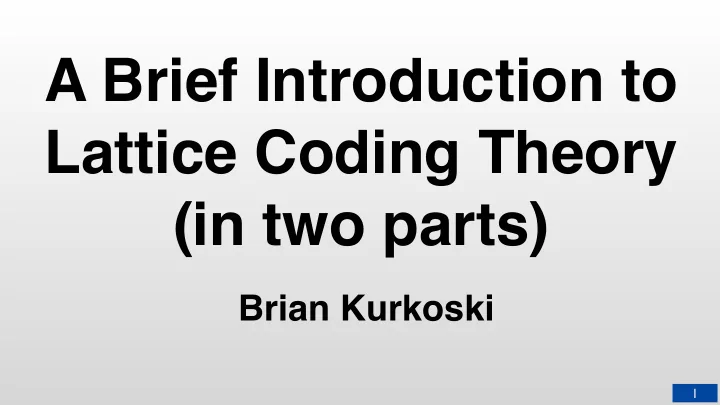

A Brief Introduction to Lattice Coding Theory (in two parts) Brian Kurkoski 1
Introduction • What is a lattice? • Why study lattices? • Real-world applications of lattices 2
Lattice Definition Definition 1 An n -dimensional lattice Λ is a discrete additive subgroup of R n . 3
Lattice Definition Definition 1 An n -dimensional lattice Λ is a discrete additive subgroup of R n . Group properties: Vector addition in R n : • has identity x = [ x 1 ] , . . . , x n • has inverse y = [ y 1 ] , . . . , y n x + y = [ x 1 + y 1 , . . . , x n + y n ] • associative • closure • (commutative) 4
Lattices in R 2 0
Lattices in R 2 a 0
Lattices in R 2 a 0
Lattices in R 2 b a 0
Lattices in R 2 b a 0 9
Lattices Beyond n=2 dimensions n = 2 n = 3 n = 4, 5, 6, ... 3 Warning 1 image not available − 3 − 1 1 3 − 1 − 3 � 10
From Such A Simple Definition Properties of lattices: •Fundamental regions •Minimum distance and coding gain •Lattice transformations — scaling, rotation, re fl ections •Lattice cosets •Generator matrix, check matrix •Quantization •Lattice codes 11
Why Study Lattices? •Lattices are error-correcting codes de fi ned over the real numbers •Lattices use the same real-number algebra as the physical world - physical-layer network coding or compute-forward •Near-ideal codes for the AWGN channel •Lossy source coding •Lattices are fun 12
Communications on AWGN Channel y x z � 13
x
4 3 2 1 x y 0 1 2 3 4
Physical World is Real-Valued 2 User 1 5 Destination 3 User 2 Electromagnetic signals have linear superposition • Codes over the real numbers are natural • Lattices have a group structure — physical layer network coding 16
2 Users Signals Superimpose Linearly � s 2 ( t ) = A 2 cos ω t + φ 2 ) s 1 ( t ) + s 2 ( t ) � s 1 ( t ) = A 1 cos ω t + φ 1 ) s 2 ( t ) s 1 ( t ) s 1 ( t ) + s 2 ( t ) φ √− 1 � � Signal real/imaginary A i exp Transmitted signals add 17
Lattice Compute and Forward h 1 relay x 1 h 1 x 1 + h 2 x 2 u 1 = h 1 x 1 + h 2 x 2 relay only wants a linear combination transmitters do not h 2 need to know h 1 , h 2 Fading coefficients x 2 18
Lattice Compute and Forward h 1 relay x 1 h 1 x 1 + h 2 x 2 u 1 h 3 u 1 � h 1 � x 1 � h 2 = · u 2 h 3 h 4 x 2 h 2 relay h 3 x 1 + h 4 x 2 u 2 h 4 Invert this matrix, recover x 1 , x 2 x 2 19
AWGN Channel, Power Constraint P A Gaussian input distribution will achieve channel capacity � 20
Input Distribution of a Codebook SHANNON Spherical codebook Gaussian input distribution LATTICE Nested Lattice Code � 21
Practical Applications of Lattices • V.34 telephone cmodems at 33.6 kbits uses D4 lattice. • Lossy source coding ITU-T 729.1 speech-coding Gosset lattice E8 Input Output y = ( y 1 , y 2 , … , y n ) speech, image, etc. 22
Lattices Are Fun
Study of Regular Division of the Plane with Reptiles (1939) by M. C. Escher 24
Systematic Way to Form Tessellations J. Croft, http://ssrsbsta ff .ednet.ns.ca/jcroft2 25
Efficient Arrangement of Spheres In two dimensions 2 2 1 1 0 0 1 1 Hexagonal Rectangular is most efficient 26
Efficient Arrangement in Space Hexagonal is most efficient Rectangular 27
28
All the Elegance of Lattices John Conway and Neil Sloane, Sphere Packings, Lattices and Groups , Springer, Third Edition, 1999 29
Forney’s Lecture Notes http://dspace.mit.edu/ G. David Forney, Lecture notes for Principles of Digital Communications II Course at MIT Google “David Forney lecture notes” 30
The Latest In Lattice Coding Ram Zamir, Lattice Coding for Signals and Networks Cambridge University Press September 2014 31
Recommend
More recommend